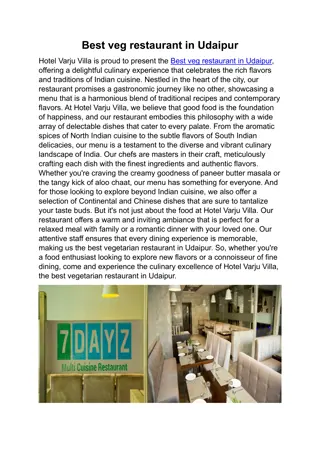Current Customer Factors Impacting the Restaurant Industry Today
Customer expectations in the restaurant industry are evolving, with taste, value, and convenience remaining key factors. Millennials and Gen Zers have distinct preferences, such as a focus on healthy options and a willingness to pay more for quality. Restaurant establishments must adapt to meet these changing demands to attract and retain customers effectively.
Download Presentation

Please find below an Image/Link to download the presentation.
The content on the website is provided AS IS for your information and personal use only. It may not be sold, licensed, or shared on other websites without obtaining consent from the author.If you encounter any issues during the download, it is possible that the publisher has removed the file from their server.
You are allowed to download the files provided on this website for personal or commercial use, subject to the condition that they are used lawfully. All files are the property of their respective owners.
The content on the website is provided AS IS for your information and personal use only. It may not be sold, licensed, or shared on other websites without obtaining consent from the author.
E N D
Presentation Transcript
Current Customer Factors Impacting the Industry As with many retail sectors, demographic shifts and other factors are impacting the restaurant industry. Customer expectations seldom change, however, and taste, value and convenience are still important, but they must be delivered differently today. According to Facebook s 2019 Restaurant Trends and Insights Report, taste influences 79% of consumers choice of where to eat, the #1 factor. Online food-related content is particularly decisive for Millennials, as it influences 86% to visit a new restaurant. Value is bit more difficult to define, but the Facebook research found it was the #1 factor among 67% of diners when they are deciding where to eat and another 34% defined value as receiving an unexpected bonus, in terms of a food item or perk at their table.
Customers Have a Long List of Wants and Desires Healthy food choices remains one of the most critical factors affecting consumers dining choices. Clean ingredients are essential to serving healthy food, as a 2019 Ingredion study found 32% would shun a particular restaurant without natural ingredients. More than 50% of consumers say they want more nutritional offerings at restaurants to satisfy their diet choices, with paleo, keto and Whole 30 being the top three. Consumers want less fat and sugar as well as dairy-free milk substitutes. The casual-dining segment has suffered from the popularity of quick-service and fast-casual restaurants, but according to Technomic research, 34% of consumers say they are less likely to choose a casual restaurant because of high prices.
Capturing Gen Zers for a Lifetime As Millennials age, marry, start families and buy homes, Gen Z is the next generation on restauranteurs radar. Gen Zers share of total foodservice traffic is already 24%. With the oldest Gen Zers 23 years of age, many of them are still in college. According to Technomic data, 25% of them eat at or order from off-campus restaurants, 31% are willing to pay more for low- calorie items, and 53% for fresh food. Many Gen Zers are also teens and, according to Piper Jaffrey s latest Taking Stock with Teens report, they expect to spend 4% less during fall 2019 compared to fall 2018; however, Chick-fil-A is still their favorite restaurant, and spending there has increased.
Millennials Are Still Restaurant Customer Royalty Restauranteurs haven t forgotten Millennials, especially now they are parents. According to The NPD Group, 5% more Millennials with children visited a restaurant during 2018 compared to 2017, with 7.3 billion visits to quick- service restaurants. 46% of Millennial families ate their restaurant meals at home, 30% ate at the restaurant and the remaining 24% ate in their vehicle, at work or another location. According to The Media Audit s 2019 Aggregate Survey, 15.5% of the 7.7 million target persons who were frequent restaurant diners were adults 25 44, 34.7% were in the $50K $100K income bracket and 50.5% had a college or advanced degree.
A World of Flavors Is Required to Compete To create and serve the menu items that will attract a diverse customer base, more restaurants are incorporating not just healthier, fresh ingredients, but also Asian and Middle Eastern food cultures, and substitutes: carob for chocolate, for example. The Media Audit s 2019 Aggregate survey also reveals younger adults, by ethnicity, are primary restaurant audiences, with 18 24 Latinx Americans particularly significant, at 36.8%, and those 25 44, at 29.1%, and an index of 136. The largest age group for African Americans was 18 24, at 19.9%, and 25 44 for Asian Americans, at 10.7%, and in which they indexed the highest, at 136.
Advertising Strategies Of consumers three most important factors when choosing a restaurant, taste is first. Independent restaurants, specifically, can highlight how they deliver greater taste in their advertising, especially if they use a spice or flavoring package that is a family secret. Although the Facebook study found value, another important factor, difficult to define, for many restaurant guests it s as simple as a bonus food item, such as a dessert. Independent restaurants can also use this correlation to help boost foot traffic and customer retention. More Millennials are transitioning from the single life to parenthood and, according to the research, more of them with children are likely to visit a restaurant. Restaurants must make themselves as inviting as possible to families and emphasize that in their advertising.
New Media Strategies Not only is online food-related content critical to attracting Millennial diners, but also older Gen Zers. That content should always try to distinguish the restaurant by taste, value and convenience as well as content that focuses on new menu items and posts of chef videos. Much of that online content should also emphasize the healthy, fresh choices, including designating those that adhere to specific diets as well as how the chef is incorporating some of the new trends into the menu, especially ingredients from Middle Eastern food cultures. Share The Media Audit data on page 4 of the Profiler with prospects and clients to help them determine which sport/team best matches their target audience, and then use social media posts, especially videos, to show how patrons follow and celebrate their sport/team.























